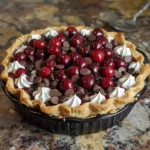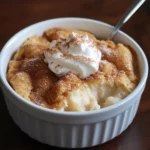Description:
Crema Pasticcera, the heart of Italian pastry making, is a rich, smooth, and versatile custard used in countless desserts. This recipe provides a detailed guide to creating a flawless pastry cream, perfect for filling cakes, pastries, tarts, and so much more. With a few simple ingredients and careful attention to technique, you can achieve a decadent cream that rivals any you’ve tasted in Italy. This recipe balances traditional methods with clear, modern instructions, ensuring success for both novice and experienced bakers.
Ingredients:
- 1 cup milk, divided (preferably whole or 2%)
- 1 cup heavy whipping cream
- 2/3 cup granulated sugar (for a lightly sweet custard, only add 1/2 cup sugar)
- 5 large egg yolks, room temperature
- 1/2 tablespoon all-purpose flour
- 2 tablespoons cornstarch
- 2 tablespoons salted butter (if using unsalted butter, add 1/8 teaspoon salt to the milk and sugar mixture in step 1)
- 1/2 teaspoon vanilla extract (or 1 vanilla bean, scraped)
Preparation:
Achieving the perfect Crema Pasticcera is all about methodical preparation and attention to detail. Here’s a breakdown of the steps:
- Step 1: Infuse the Cream: In a medium saucepan, combine ½ cup of the milk, the heavy cream, and sugar. Gently whisk to ensure the sugar begins to dissolve. Place the saucepan over medium heat.
- Step 2: Warm the Mixture: Heat the mixture, stirring constantly with a whisk, until it begins to steam and is almost boiling. You’ll see small bubbles forming around the edges, but ensure it doesn’t fully boil. This usually takes about 4-5 minutes. Remove the saucepan from the heat and set aside. If using a vanilla bean, slice it lengthwise, scrape out the seeds, add both the seeds and the pod to the milk mixture.
- Step 3: Prepare the Egg Yolk Mixture: While the milk mixture is heating, in a large bowl, whisk together the egg yolks, all-purpose flour, cornstarch, and the remaining ½ cup of milk until the mixture is smooth and homogenous. It’s crucial to eliminate any lumps, as these can lead to an uneven texture in the final cream.
- Step 4: Temper the Egg Yolks: Tempering is crucial to prevent the eggs from scrambling when added to the hot liquid. Gradually whisk a few tablespoons of the hot milk mixture into the egg yolk mixture, whisking constantly and vigorously. This slowly raises the temperature of the egg yolks, preventing them from curdling when added to the rest of the hot liquid. Continue adding small amounts of the hot milk, whisking continuously, until the egg yolk mixture is warm to the touch.
- Step 5: Combine and Cook: Pour the tempered egg mixture through a fine-mesh strainer back into the saucepan with the simmering milk mixture. This step is vital for removing any bits of cooked egg that may have formed during the tempering process, ensuring a silky-smooth final product. Stir to incorporate the egg mixture evenly into the hot milk mixture.
- Step 6: Cook and Thicken: Return the saucepan to medium heat. Cook, stirring constantly and vigorously with a whisk, until the mixture comes to a simmer. This should take about 5 minutes. Once it simmers, continue cooking for one minute, still stirring constantly, until the mixture thickens noticeably. The pastry cream is ready when it coats the back of a spoon and a line drawn through it with your finger holds its shape.
- Step 7: Final Touches: Remove the saucepan from the heat. Immediately strain the pastry cream through a fine-mesh strainer into a metal or glass bowl set over an ice bath. This stops the cooking process and helps cool the cream quickly, preventing further cooking and potential curdling. Stir in the butter and vanilla extract. The butter adds richness and creaminess, while the vanilla extract provides the classic flavor. If you used a vanilla bean, remove the pod at this point.
- Step 8: Chill and Store: Press a piece of plastic wrap directly against the surface of the pastry cream (this prevents a skin from forming). Refrigerate until completely cool, about 2-3 hours. Once cooled, store in a covered container in the refrigerator and use within 5 days.
Why You Will Love This Recipe:
This Crema Pasticcera recipe is a game-changer for any home baker. It provides a foolproof method for creating a pastry cream that is:
- Versatile: Perfect for filling pastries, cakes, tarts, éclairs, and more.
- Smooth and Silky: The straining and tempering techniques ensure a lump-free, luxurious texture.
- Flavorful: The combination of milk, cream, and vanilla creates a rich, balanced flavor.
- Impressive: Easily elevate your desserts with this classic Italian cream.
- Adaptable: Adjust the sweetness to your liking by reducing the sugar.
Cooking Rating:
- Difficulty: Medium
- Requires consistent attention and proper technique
Serving Suggestions:
- Pastry Filling: Use as a filling for cannoli, éclairs, cream puffs, or croissants.
- Cake Layer: Spread between cake layers for a decadent dessert.
- Tart Filling: Pour into a pre-baked tart shell and top with fresh fruit.
- Dessert Parfait: Layer with berries and crumbled cookies for a simple yet elegant parfait.
- Breakfast Treat: Swirl into pancakes or waffles for an indulgent breakfast.
- As a Sauce: Drizzle over fresh fruit or grilled peaches.
- As a base of other creams: You can flavor and turn the cream into other creams such as a chocolate one, or a pistachio one
Tips:
- Use Quality Ingredients: Fresh, high-quality ingredients will yield the best flavor and texture.
- Stir Constantly: Don’t skip stirring! It prevents burning and ensures even cooking.
- Don’t Overcook: Overcooking can lead to a grainy texture. The cream is ready when it coats the back of a spoon.
- Use an Ice Bath: Cooling the cream quickly in an ice bath prevents it from developing a skin and stops the cooking process.
- Salted Butter: Adds a delightful balance to the sweetness of the pastry cream. If using unsalted butter, add a pinch of salt to the milk mixture.
- Flavor Variations: Infuse the milk with lemon zest, orange zest, or spices for unique flavor profiles.
Prep Time: 15 minutes Cook Time: 20 minutes Total Time: 35 minutes (plus 2-3 hours chilling time)
Nutritional Information: (Approximate, per serving, recipe yields about 6 servings)
- Calories: 250-300
- Protein: 5-7g
- Sodium: 50-75mg (depending on butter used)
Conclusion:
Crema Pasticcera is more than just a recipe; it’s a foundational element of Italian pastry. Mastering this cream opens a world of possibilities for creating exquisite desserts. While it requires attention to detail, the reward is a smooth, rich, and versatile pastry cream that will elevate your baking to new heights. Embrace the process, follow the tips, and you’ll be enjoying this Italian classic in no time!
Questions and Answers:
- Question: Can I use skim milk instead of whole milk or 2% milk? Answer: While you can use skim milk, the resulting pastry cream will lack the richness and creamy texture that comes from the higher fat content in whole or 2% milk. Using skim milk may also affect the overall thickening process, potentially leading to a thinner cream. For the best results, stick with whole or 2% milk, or at least a milk with some fat content.
- Question: What happens if my pastry cream becomes lumpy? Answer: If your pastry cream becomes lumpy, don’t panic! There are a few things you can try. First, immediately remove it from the heat and whisk vigorously to break up the lumps. If that doesn’t work, pass the pastry cream through a fine-mesh sieve or strainer. This will remove any larger lumps and leave you with a smoother texture. Preventatively, be very vigilant when cooking and stir constantly. Tempering the egg mixture and cooking at a medium heat will also help prevent lumps.
- Question: Can I make this recipe ahead of time? Answer: Absolutely! In fact, it’s recommended to make Crema Pasticcera at least a few hours in advance to allow it to chill and thicken properly. You can make it up to 5 days in advance and store it in an airtight container in the refrigerator. Just be sure to press plastic wrap directly onto the surface of the cream to prevent a skin from forming.
- Question: Is there a substitute for cornstarch in this recipe? Answer: While cornstarch is the preferred thickening agent for its ability to create a smooth and glossy texture, you can substitute it with an equal amount of arrowroot powder or tapioca starch. However, keep in mind that these substitutes may result in slightly different textures. Using too much flour is not recomended
- Question: Can I freeze Crema Pasticcera? Answer: While technically you can freeze Crema Pasticcera, it is not recommended, as the texture can change and become grainy upon thawing. The freezing process can break down the emulsion and affect the overall smoothness. If you must freeze it, use it within a month and thaw it slowly in the refrigerator. Whisk vigorously after thawing to try to restore the original texture. Freshly made Crema Pasticcera is always best for optimal quality.




